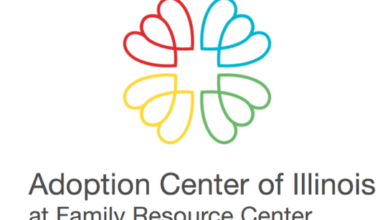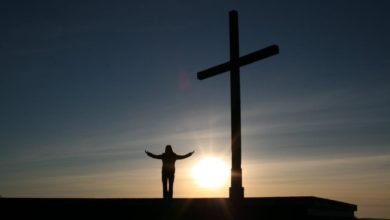MANDELA IN CHICAGO: Behind the Scenes of the Nelson Mandela Documentary with Director Ava Thompson Greenwell, Ph.D.
Written by Jon-Michael Foshee

Deprecated: htmlspecialchars(): Passing null to parameter #1 ($string) of type string is deprecated in /home3/contiod3/public_html/chicagodevotion/wp-includes/formatting.php on line 4732
Mandela In Chicago, the compelling new documentary from Ava Thompson Greenwell, Ph.D., can be found in your local PBS broadcast listings.
*This article was originally posted on ChicagoDevotion.com on February 21, 2021. In remembrance and honor of Nelson Mandela and the many people who fought so hard to end apartheid, we at Chicago Devotion will be re-posting this article annually so that we may never forget where we came from, or those who came before us.
In 1990, after Nelson Mandela was released from prison on Robben Island, a South African man stood amongst the crowd of South Africans and Americans gathered together in United Trinity Church of Christ on Chicago’s South Side. This man was once imprisoned in the cell next to Nelson Mandela, and as a chorus of voices sang around him, he spoke the names of all the political prisoners who had died on Robben Island for their struggle to unleash freedom by ending apartheid.
After each name he said, “Siyabonga,” which means, “Thank You.”
“This is very much a Chicago story, because when it comes to the anti-apartheid movement, there have been a lot of conversations about the global movement, about movements in the U.S. on both coasts, but the Midwest doesn’t get a lot of love,” Director Ava Thompson Greenwell, Ph.D. said. “My goal was to do Chicagoans right by this film and to make sure they were documented, that the work they did was documented. It was so powerful.”
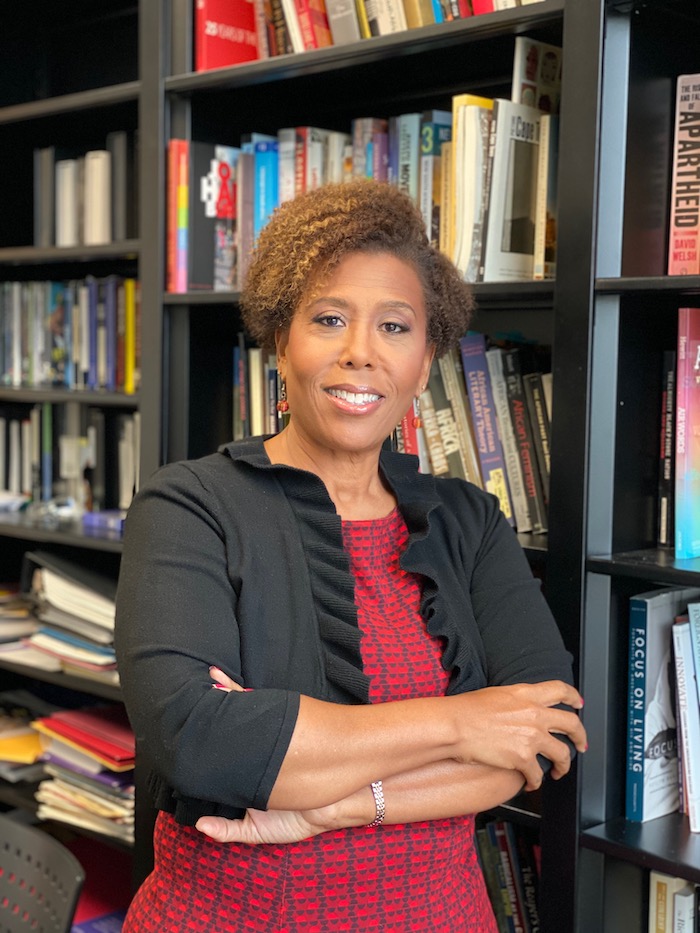
“The connection between Black Americans and Black South Africans goes back to the 1800s,” Dr. Greenwell narrates in the documentary.
“There were African Americans in South Africa, Cape Town, as early as 1819. They were there as sailors,” Cheryl Johnson Odim states in the documentary. “A major part of the commercial trading sailing network was African Americans. That early group of people was treated differently than Black South Africans, but they still recognized what was going on in terms of the way that Black South Africans were treated.”
“This was a learning process for me as well,” says Dr. Greenwell. “There were some things I learned that just blew my mind. The fact that enslaved African Americans were actually going to South Africa on a ship called the Alabama in the 1800s – I didn’t know that history. There are scholars who have written about it, but there is so much information that Americans just don’t get taught in school, and still aren’t being taught.”
“With the rise of Black Power in the United States, we were talking about Black consciousness,” Mosiuoa “Terror” Lekota states in the documentary. “It was important for the Black communities to be aware of themselves and to refuse to accept the second-rate status as citizens of this country. Ultimately, we were arrested for that.”
“By the early 1900s, Black Baptists and African Methodist Episcopal churches sent missionaries to South Africa to teach the Bible and care for orphans,” Dr. Greenwell narrates.
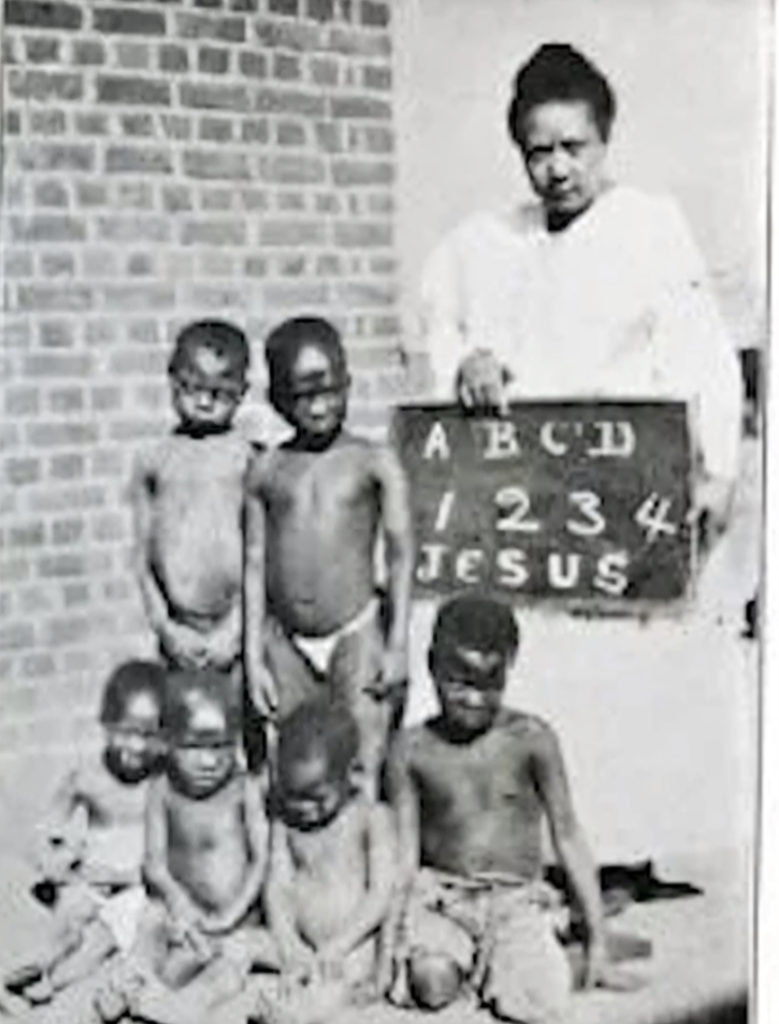
“The AME church began to be banned inside South Africa because the South African state saw them as encouraging opposition to the way Black South Africans were being treated,” Cheryl Johnson Odim states in the documentary.
“Given these historical connections, it’s not surprising that when the offspring of enslaved African Americans moved north to Chicago as part of the Great Migration, they strongly identified with Black South Africans who were forced to live under a strict system of racial separation and inequality called apartheid,” Dr. Greenwell narrates.
In the 1970s, South Africans made regular trips to Chicago. The Chicago & Illinois Chapter of the National Anti-Imperialist Movement In Solidarity With African Liberation was founded at Dunbar High School in 1973. One of the speakers was Oliver Tambo, the President of the African National Congress (ANC), who preceded Nelson Mandela. It was during Tambo’s speech that many Chicagoans in attendance noticed similarities between Black South Africans and African Americans growing up in the Southern United States.
“It’s the people, how they dedicated themselves to our struggle as if they were experiencing the pain and the hurt of the people of South Africa,” Lindiwe Mabuza, former U.S. Representative of the African National Congress, states in the documentary. “Of course, I suppose in some way it was easier for them since they were not so free after all.”
“We would say, ‘freeing South Africa is freeing ourselves.’” Mike Elliott states in the documentary.
So many of us witnessed people attending protest events and watched as organizations did these great big things, but what can ‘a person like me’ do to help? Turns out, one person can do a lot.
Prexy Nesbitt housed seventy-eight South Africans in his home as they came to Chicago throughout the years. Chicagoans were holding barbecue fundraisers and donating the funds to the African National Congress; they were forming organizations and introducing legislation into local and state governments to change the system from the inside.
The power of just gathering people together in your neighborhood for a cause, making time to educate yourself about the struggles of our own history, attending protests against injustice – just getting involved is the way they helped every day, the way you can help every day.
“And this is pre-social media,” Dr. Greenwell said. “You have to remember, they had to do flyers. Yeah, that part was amazing. Their goal as organizers was to make sure they educated Chicagoans about this. Let’s just be honest, they (Chicagoans) were like me. I saw the sign (‘FREE SOUTH AFRICA’) but I’m not quite sure…South Africa, what does that really mean? They had to make sure that Chicagoans heard from South Africans directly; that was their goal.
“They felt as though if they can hear from South Africans about what life was like, then people would understand the connection to Chicago’s civil rights and discrimination, and be more inclined to participate, to see those connections.
“Even though you’re eight thousand miles away, you still have a connection to this individual. Even though they may speak eleven different languages, you still have a connection to this person, because discrimination is discrimination, no matter where it exists. Just like we’re trying to eliminate the discrimination there, they would really try to make those connections between Chicago and South Africa, and the best way to do that was to give them someone who had experienced it.
“So, the fact that Prexy Nesbitt had people staying at his house, that was amazing. When he said ‘seventy-eight,’ I was like, ‘You had seventy-eight South Africans staying there?’ But that’s Prexy for you, Prexy’s been involved in this for the long haul,” Dr. Greenwell said.
Chicagoans who were facing institutional racism at home made the time and took great effort to raise money to fight racism and oppression against people in another country they had never met, but in whom they saw themselves.
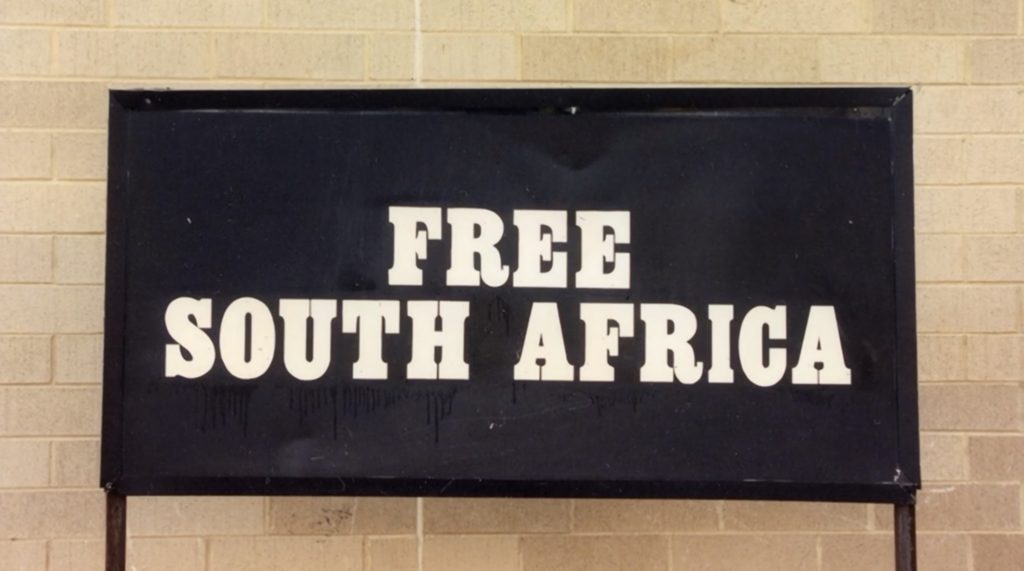
Reverend Jeremiah Wright and the people of Trinity United Church of Christ put up the first ‘FREE SOUTH AFRICA’ sign outside the church in 1980. This was the first in Chicago, in Illinois, if not the nation.
“It only cost one hundred dollars. We bought the sign and put it up. I mailed three thousand postcards asking people to join me by buying signs and got zero responses in terms of, ‘okay, we’ll do it,’” Rev. Jeremiah Wright states in the documentary of their fundraising efforts.
That sign would ignite multiple fundraising efforts through massive events and even backyard and neighborhood barbecues, with the proceeds going to the African National Congress (ANC) in South Africa. But the most inspiring result is that the ‘FREE SOUTH AFRICA’ sign would go on to become a beacon of hope and a rallying cry that crossed the Atlantic, even entering the hearts of the men imprisoned with Nelson Mandela himself.
“The ‘FREE SOUTH AFRICA’ sign outside the Trinity United Church of Christ was known in Robben Island prison in South Africa, and anti-apartheid protestors who were imprisoned wanted to come visit Chicago after they got out,” Dr. Greenwell said.
“I grew up not too far from Trinity United Church of Christ. I remember that sign (Free South Africa) when I was in high school, but I don’t think I really knew what it meant. Growing up on the South Side of Chicago, things are very insular. It’s about your neighborhood and what neighborhood you live in versus the global world.
“When I think back on it, and having interviewed Jeremiah Wright about that, it was so important for him to put that in perspective; he was really ahead of his time. I think people will remember him because of the Obama issue, but what they don’t know is that he was doing things that were proactive and global starting in the 1970s. Unfortunately, he’s been painted a certain way because of his connection to Obama, so this story shows his humanity,” Dr. Greenwell said.

When Nelson Mandela was released from the Robben Island prison in 1990 and walked into South Africa a free man, Chicago joined in the celebration. His fellow prisoners traveled to the United States to visit Trinity United Church of Christ in Chicago, the South Side church with “The Sign.” These men all promised each other that they would travel to the United States to visit Trinity United if they ever made it out of Robben Island prison alive.
“I hope that this is also a teachable moment, not only to all people, but in particular to a new generation of young people so they can understand that, ‘I live in Chicago and there are people living in my backyard who are doing this kind of work,’” Dr. Greenwell said. “It is possible to have an impact, it is possible to influence governments. It is possible to make a difference. Because sometimes people feel like, ‘I’m just one person, I can’t make a difference.’ But they can see that when people moved together, they actually did make a difference.
“Two main things sparked the idea for Mandela In Chicago,” Dr. Greenwell said. “The first is I was asked to take over the South African Journalism Residency Program at the Medill School of Journalism at Northwestern University. My predecessor had brought the program to the school in 2001 and he was planning to retire.
“In 2014, he said he would love for me to be the second person involved, and we rotated with another professor, Doug Foster, who wrote the book, After Mandela. I didn’t know very much about South Africa, but my predecessor said I would learn.
“So, sitting in on his class, he had brought in Funeka Sihlali, a South African Chicagoan who is in the documentary, and someone else brought in Prexy Nesbitt. When Prexy Nesbitt came in, he started telling us about all these other people who were involved. I started thinking, ‘I didn’t know all this history; who are these people?’
“And it turned out there were people right in my neighborhood, who lived in Evanston, who were involved in the anti-apartheid movement, like Basil Clooney, for example. Gloria Clooney was the drama teacher at my kids’ middle school. So, I began to see all these connections, but I also understood I didn’t know all this history. It was a feeling of, ‘You did what? How come I didn’t know about that?’”
“The second thing was I became a Fellow for the Diverse Voices in Documentary Program through Kartemquin Films in 2016, and I needed a topic,” Dr. Greenwell said. “I didn’t have anything shot. Some of the other Fellows already had ideas, so I thought this would be a great idea. I’m from Chicago and I have access to some of these people.
“The other thing was, with this Fellows program, I had just traveled to Israel and Palestine in 2015. In December 2015, when the application for the 2016 Kartemquin Program was due, I was in Israel and Palestine for about a week, and it struck me that Palestinians are experiencing the exact same things that Black South Africans had experienced for years: the occupation of their land, the surveillance balloons they had while we were there, the ghettoizing of people, and poor housing, even access to water for the Palestinians.
“They were experiencing the same types of discriminations that Black South Africans and Black Chicagoans have been experiencing for years. I saw these connections and these synergies and thought, okay, that’s my topic, without really knowing the whole idea of Mandela coming to Chicago in 1993.
“I had just moved back to Chicago in August 1993, so I wasn’t here for all the fanfare, I missed all that. I had no idea of everything that happened up to that visit, so I could approach it with a fresh set of eyes,” Dr. Greenwell said.

When Nelson Mandela finally arrived in Chicago in 1993, his visit was mostly consumed by the local politicians who wanted photo opportunities with him and whisked him from one event to another. But Mandela’s presence and his words rang true with the people of Chicago:
“I will go back to my country full of strength, like a battery that has been charged.”
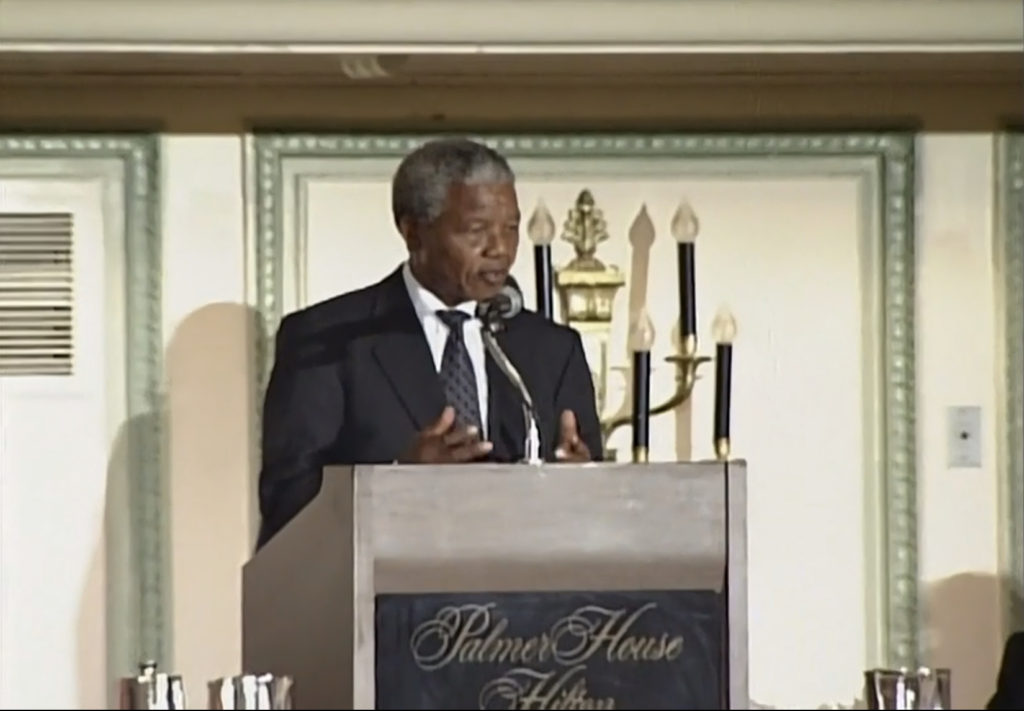
Mandela’s two-day visit to Chicago resulted in two million dollars in fundraising for the African National Congress. Local organizers felt empowered, as their efforts were worth it, but they also understood there was more work to be done.
“We wanted to show our children that the world was bigger than the West Side of Chicago. We felt that was so important, so that they could have a concept of the world, because we never know where our children will be or what they can achieve,” Ronelle Mustin states in the documentary.
“As part of the residency program where we take students who work as junior reporters in newsrooms in South Africa, I will go to visit them, check on them, make sure everything is okay,” Dr. Greenwell said. “So, I tell one of my colleagues about a trip and they said there are two people who have been accepted to the program who are from South Africa and are thinking of coming to the program. I thought I’d meet with them while I’m there to see if they have any questions.
“Caryn Petersen, who is in the documentary, is one of the persons with whom I met, and she is a white South African. As we were meeting and I was telling her about the journalism program, I asked her if she had any questions about living in Chicago, the weather differences or anything, and she said, ‘Oh, no, I lived there when I was nine years old.’ It turned out, her parents had been staunch anti-apartheid activists, minister activists, within South Africa.
“And, so, again, who would have thought I would have gone there and talked to her about the Journalism Program, and she would have been someone who had lived in Chicago, on the South Side in Hyde Park, for about five years and had attended school.
“Their story had become pivotal, because as white South Africans, I thought it was really interesting what their experience was like living in a predominantly Black neighborhood. She talks about going to school, and her dad talks about going to the suburbs and some white suburbanites found out he was from South Africa. A few suburbanites told him, ‘Hey, you know how to treat your Black folks there,’ but they didn’t use the term ‘Black folks.’ And, also, you see how they were treated by Black people — throwing their popcorn on the floor.
“So, the racial dynamics really became clear as you talk to white South Africans and what their experience was like in Black Chicago. I thought that was really fascinating how that came together,” Dr. Greenwell said.
“Even meeting Duane Buford, our composer, it was through Tristan Hanson, and I didn’t even know her,” Dr. Greenwell said. “I happened to see an ad for her documentary, Blueprint for Bronzeville, which was playing in Evanston, and I thought it looked pretty interesting.
“I get to the screening and I run into Chaga Walton — he was on the Board for the Black Harvest Film Festival. I had done a rough-cut screening of Mandela In Chicago around 2018 and Chaga was there, and it turned out his wife had been a participant in Blueprint for Bronzeville. We met the director there, and she talked about the music in the film.
“So, afterwards I went up to her and said, ‘I’m working on this documentary and I’d love to find a local musician who can help me,’ and she said, ‘Duane Buford is your man, he will help you and he will provide the music.’” Dr. Greenwell said.
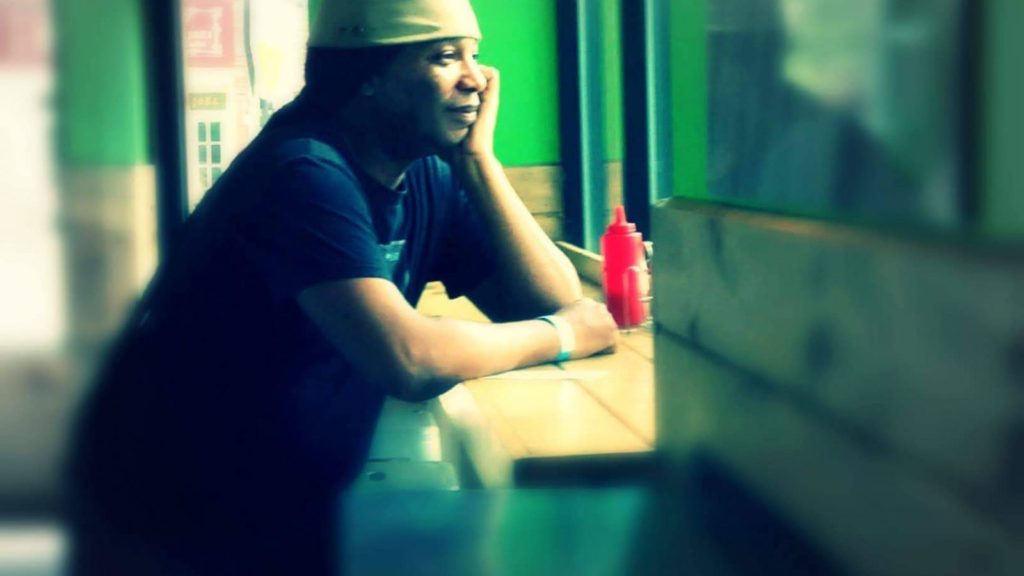
“When I came to Dr. Greenwell’s office, I had in my mind, ‘I am not leaving here without this film,'” Duane Buford said. “I am not walking out this door without securing this film. Because, for me, I remember the day Mandela got out of prison. I was at home, I watched it on television. It was a big deal on TV, he stopped everything. I saw him walking out of prison. So, I really wanted to do this film.”
Duane Buford is the Lead Composer Producer of the Mandela In Chicago documentary, and he is also a Co-Founder and Board Member of Chicago Devotion. To learn more about how Duane composed the music for this film, read our featured article on him right here.
“So, again, divine intervention,” Dr. Greenwell said. “If I had not gone to that screening, I wouldn’t have met Tristan, Tristan would not have told me about Duane, and we probably would have never met. There are many other instances like that as well.
“Lisa Brock, who knew I was doing this, invited me to her house for a holiday event they have every year that includes people who were in the struggle, people who were activists. When I get there, Heidi Marshall of Columbia College is there doing a presentation about how they just acquired all this footage from the 1980s from anti-apartheid activists and they’re making it available on their website.
“And guess who was at the party? The person who shot all the footage, Mike Elliott, who was sort of the unofficial anti-apartheid videographer.
“So, all these people who I really needed to talk to were already gathered at this event. Again, that was one of those, ‘What if I had decided I’m not going to go to that because I don’t have time?’ I may have eventually found the footage, but I wouldn’t have been able to meet those people and introduce myself and tell them what I’m doing, and why it’s important for them to speak to me about this issue. Those are just a few instances. There are several other things that happened that were just divine intervention, one of which was getting that footage from Nightline about Nelson Mandela.
“It has been a labor of love, four years of working to put it together, but I have to say, there has been divine intervention all along the way,” Dr. Greenwell said.
The parallels between the struggles of South Africans and African Americans throughout the documentary are emblematic of the institutional racism that we continue to fight against today. It speaks to the education many of us received, a lot of which was glossed over. Many of us remember the term apartheid and equate it to South Africa and the name Nelson Mandela, but that’s about it.
But seeing these parallels laid bare in Mandela In Chicago is striking, the connections of what was happening in South Africa with what Black people faced throughout America, the difference being that the apartheid party in South Africa was willing to take their persecutions further.
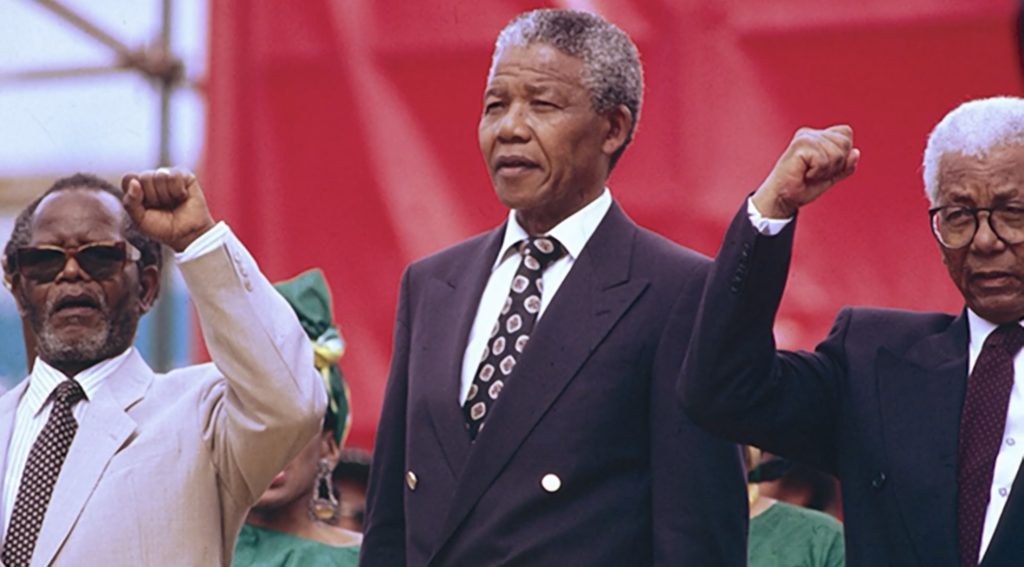
Viewers may notice that what happened to Mandela and his contemporaries throughout the documentary could very well have happened to John Lewis, Martin Luther King, Jr., Barbara Jordan, Malcom X, Rosa Parks — any one of whom would have been imprisoned had their stand occurred in South Africa.
Each one of our Civil Rights Leaders could have easily been jailed for life for standing up for equality if that type of fascist regime had existed in America at that level of cruelty.
“Look at how Moses Mayekiso and Mosiuoa “Terror” Lekota talk about when you organize in South Africa to resist you get thrown in jail,” Dr. Greenwell said. “That’s what was happening, right? And there is a blackout on information, but you have to remember that the white apartheid regime, the reason it felt it needed to be so heavy-handed, I think, in addition to just pure racism, is the population is the mirror opposite of the United States.
“You have a population that is eighty percent Black, ten percent white, and maybe ten percent Indian, whereas in the United States the Black population is only thirteen percent. If you are the minority, population-wise, and you are trying to conquer the majority, you have to be a lot more heavy-handed because you are outnumbered. You have to put in some systems that really do major damage, because otherwise people will rise up. And, obviously, they rose up anyway.
“I think that’s one of the reasons we saw apartheid as such a horrible system, like it was in the U.S., but they made it even more horrible because of the difference in population.
“It reminds me of the South during the slavery period. You would find some of those states like South Carolina and North Carolina had almost majority Black populations. They were slave populations, but they were the majority population. So, the minority had to be tougher because of the fear of insurrection – you can easily be outnumbered.
“I think it was that same concept in South Africa that if you have an eighty percent population, if you try to conquer that population, you have to put some severe restrictions in place or else you will be overrun, which was awful,” Dr. Greenwell said.
The sheer immorality of these injustices is appalling. The parallels in oppression between Black Americans and Black South Africans throughout the centuries, even as recent as the apartheid struggles of the 1980s and 1990s and the struggles that still continue today, show the crushing reality of the cruelty of which human beings are capable.
But, there is beauty to be found in the people who stand against the oppression. We can see the rock bottom of humanity in apartheid, in racism, in the violence and the injustice, but the beauty of the strength of the masses who risk their freedom, their safety, their lives to rise against injustice brings to light the best qualities of humanity.
While the struggle against inequality and oppression is ongoing, our future is filled with this light; it is not dimmed by the darkness which we overcome. Our future shines with a righteous hope that continues to rise against inhumanity at all costs, a hope that lies in the hearts and wills of the people. And that hope cannot be extinguished. It cannot be chained. It cannot be imprisoned. It cannot be systematically oppressed. It has no limitations. We must never forget our past, but instead educate ourselves so our future remembers it and can recognize it so we do not become a repetition of it. Our strength lies in that knowledge, and in one another.
“Each new generation contributes to the ongoing kaleidoscope of victory, each loss contributes ultimately to victory; it’s a process that continues always. And it’s one that we can be utterly proud of,” Prexy Nesbitt states in the documentary.
“The work that was done in the States is just so monumental. It needs its own history,” Lindiwe Mabuza states in the documentary.
“I am speaking from audience of a state and of a city who can boast of having organized and produced one of the most anti-apartheid movements in this country, if not in the world,” Nelson Mandela said of Chicagoans’ efforts during his 1993 visit to Chicago.

“My goal is to have this be a film that replays multiple times, maybe once a year, whether it’s during Black History Month, or the date of Nelson Mandela’s release, or the anniversary of him coming to Chicago — all of those events have significant timing,” Ava Thompson Greenwell, Ph.D. said of her film, Mandela In Chicago. “I’ve had librarians at university libraries reach out to me for a copy for their archives. I’m excited about the possibilities.
“I want as many people as possible to watch it for free.”
To all who continue to fight racial injustice, who strive for equality, who invite leaders and refugees alike into your homes, who barbecue to raise money for the oppressed, who organize, who protest, to those who speak out and stand up, we say Siyabonga.
Thank You.
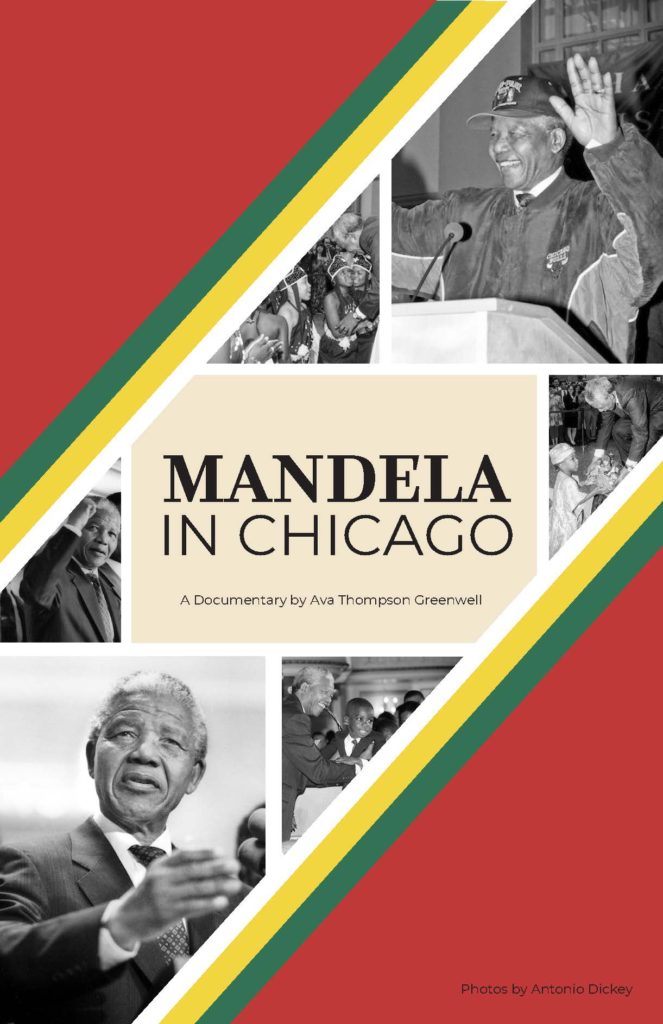
The documentary Mandela In Chicago, directed by Ava Thompson Greenwell, Ph.D., is available to stream at your convenience for free, courtesy of WTTW PBS Chicago.
You can watch it right here, right now.
For more resources and information for your needs and to enrich your daily lives, gather together on the Chicago Devotion Home Page and follow us on Facebook and Twitter.
Deprecated: htmlspecialchars(): Passing null to parameter #1 ($string) of type string is deprecated in /home3/contiod3/public_html/chicagodevotion/wp-includes/formatting.php on line 4732


